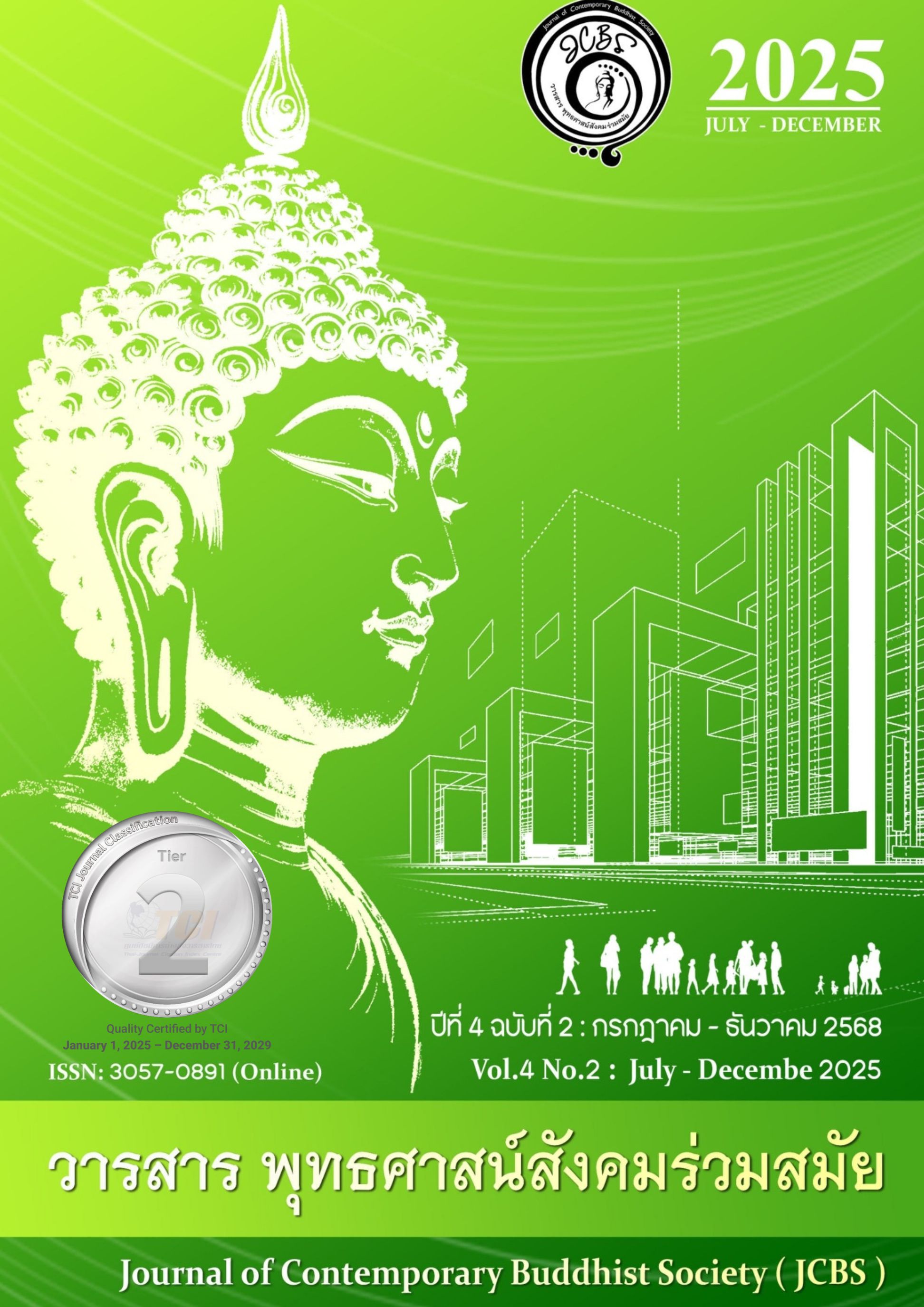BUDDHA’S TEACHINGS AND WISDOM FOR CULTIVATING FAMILY HARMONY
Keywords:
Harmony, Family Values, Conflict Resolutions, Sigālovāda Sutta, Buddhist household values, Solution to technologically driven societyAbstract
This research paper examines how the Buddha’s teachings can be applied to promote harmony within today’s family systems, especially in the context of increasing emotional stress, broken relationships and conflict in a fast-paced, technology-driven world. The main goals of the study are to explore the core Buddhist teachings on family ethics, assess their practical relevance for everyday life, and suggest general principles that can support healthy and lasting family relationships.
The method used in this study is thematic content analysis, where important ideas from the texts were identified, grouped into themes, and then linked to common family issues seen today-like conflict between parents and children, emotional stress, or lack of communication between partners. Along with the primary texts, relevant commentaries and modern writings on Buddhist ethics and psychology were also referred to for deeper understanding.
The goal was to find how the original teachings of the Buddha could help us deal with real-life problems in families today. The study highlights important causes of disharmony, such as greed (lobha), anger (dosa), and delusion (moha), and also explores positive qualities like gratitude (kataññutā), patience (khanti), truthfulness (sacca), and loving-kindness (mettā), which can support healthy relationships.
As a key contribution, the study offers a conceptual model that matches the common family problems with Buddhist teachings along with suggested actions thereby making it easier to see how the Dhamma can be applied in daily life. The study also brings together ideas like the Five Precepts and the Four Brahmavihāras that can be followed by anyone who wants to build a peaceful and caring home environment. This model may also serve as a foundation for future studies on the effectiveness of Buddhist approaches to real-world family issues.
This research contributes new knowledge by presenting a conceptual model that systematically links Buddhist virtues with contemporary family conflicts
References
Bodhi, B. (2000). (Ed.). A comprehensive manual of Abhidhamma: The Abhidhammattha Saṅgaha of Ācariya Anuruddha. Pariyatti Publishing.
Bodhi, B. (2017). The Sutta-Nipāta: An ancient collection of the Buddha’s discourses together with its commentaries. The Pali Text Society.
Buddhaghosa, A. (2000). Dhammapadaṭṭhakathā (The commentary on the Dhammapada). (S.D. Śāstri, Trans.; P. Singh, Ed.; Vol. 1).
Bauddha Ākara Granthamālā, M.G. Kāshi Vidyāpīth.
Buddharakkhita, A. (Trans.). (1996). Dhammapada: The Buddha (Buddhavagga, verse 184). Access to Insight. https://www.accesstoinsight.org/tipitaka/kn/dhp/dhp.html
Burlingame, E. W. (Trans.). (1921). Buddhist legends: Translated from the original Pali text of the Dhammapada commentary (C. R. Lanman, Ed.; Harvard Oriental Series, Vol. 30). Harvard University Press.
Chaiworamankul, Y. (2017). Buddhist-based solutions over the Thai family problems. Journal of Peace Studies, 5(1), 370–384.
Khuddaka Nikāya. (1995). Dhammapada-Aṭṭhakathā, Paṭhamo Bhāgo. Vipassana Research Center.
LatestLaws.com. (2015). Divorce fact sheet: Where India stands in the world. https://www.latestlaws.com/did-you-know/divorce-fact-sheet-india-stands-world/
Mahatthanadull, S. (2017). The integrated way for the balance of family life based on Buddhist doctrines and Bowen’s theory (Doctoral dissertation). Mahachulalongkornraja vidyalaya University, Thailand.
Mahatthanadull, S., & Mahatthanadull, S. (2020). Human behaviors in promoting balance of family according to Buddhist psychology. Journal of MCU Peace Studies, 8(1).
Statista. (2023). Availability of old age homes/shelters for the aged in India 2021 [Graph]. https://www.statista.com/statistics/1302781/india-availability-of-old-age-homes-shelters-for-the-aged/
Sujato, B. (Trans.). (2018). Maṅgala Sutta: Discourse on blessings (Sutta Nipāta 2.4). SuttaCentral. https://suttacentral.net/snp2.4/en/sujato
Sujato, B. (Trans.). (2018). Parābhava Sutta: Downfall (Sutta Nipāta 1.6). SuttaCentral. https://suttacentral.net/snp1.6/en/sujato
Sujato, B. (Trans.). (2018). Paṭhama Samajīvī Sutta: Living in harmony (Aṅguttara Nikāya 4.55). SuttaCentral. https://suttacentral.net/an4.55/en/sujato
Sujato, B. (Trans.). (2018). Pema Sutta: On love (Aṅguttara Nikāya 7.60). SuttaCentral. https://suttacentral.net/an7.60/en/sujato
Sujato, B. (Trans.). (2018). Sigālovāda Sutta: To Sigāla (Dīgha Nikāya 31). SuttaCentral. https://suttacentral.net/dn31/en/sujato
Sujato, B. (Trans.). (2018). Vasala Sutta: The outcaste (Sutta Nipāta 1.7). SuttaCentral. https://suttacentral.net/snp1.7/en/sujato
Suttapiṭaka. (1993). Dīgha Nikāya, Tatiyo Bhāgo: Pathikavaggapāli. Vipassana Research Center.
Suttapiṭaka. (1995). Aṅguttara Nikāya. Vipassana Research Institute.
Suttapiṭaka. (1995). Khuddaka Nikāya: Khuddakapāṭhapāli, Dhammapadapāli, Udānapāli. Vipassana Research Center.
Swe Swe Mon. (2019). Overcoming conflicts and tension within family: A Buddhist response. In T. N. Tu & T. D. Thien (Eds.), Buddhist approach to harmonious families, healthcare and sustainable societies (pp. 197–209). Hong Duc Publishing House.
Thanissaro, B. (Trans.). (2002). Kataññu Sutta: Gratitude (Aṅguttara Nikāya 2.31). Access to Insight. https://www.accesstoinsight.org/tipitaka/an/an02/an02.031.than.html
Thanissaro, B. (Trans.). (2020). Subhāsita Sutta: Well-spoken speech (Aṅguttara Nikāya 5.198). SuttaCentral. https://suttacentral.net/an5.198/en/thanissaro
Walshe, M. (Trans.). (1995). The long discourses of the Buddha: A translation of the Dīgha Nikāya. Wisdom Publications.
World Population Review. (2024). Divorce rates by country 2024. https://worldpopulation review.com/country-rankings/divorce-rates-by-country
Downloads
Published
How to Cite
Issue
Section
License
Copyright (c) 2025 Journal of Contemporary Buddhist Society = JCBS

This work is licensed under a Creative Commons Attribution-NonCommercial-NoDerivatives 4.0 International License.



